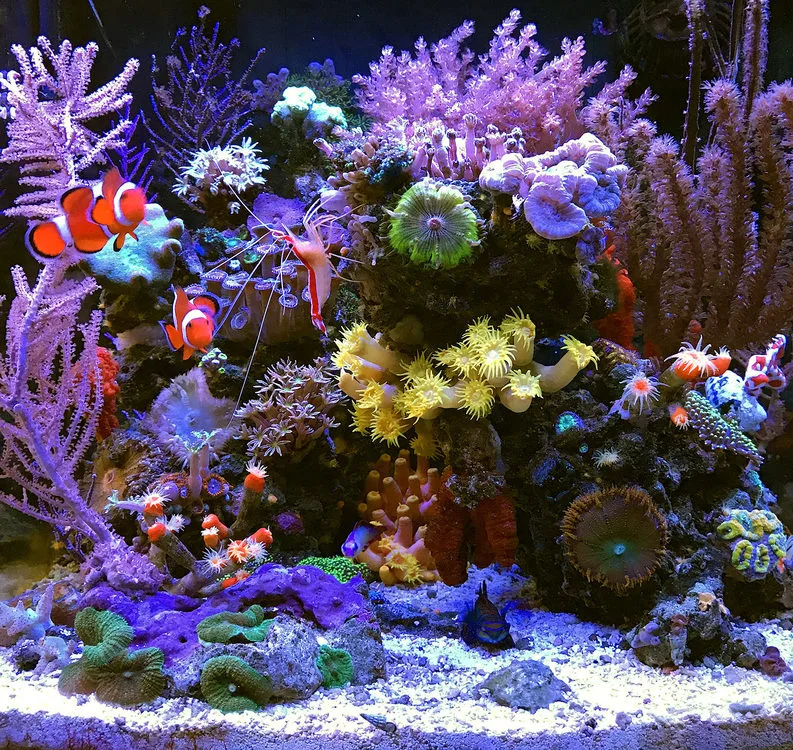Stunning 16-Gallon Reef Tank – banasophia's TOTM | NanoReef

Tank Specifications
Volume: 16 Gallons / 60 Liters
Dimensions (L × W × H):
15.0" ×
16.5" ×
17.5"
38.1cm ×
41.9cm ×
44.5cm
Equipment List
No equipment information available
Frequently Asked Questions
How do I cycle my reef tank effectively?
To cycle your reef tank effectively, consider using a combination of cured live rock and live sand, which will help establish beneficial bacteria. Products like Nutri-Seawater and BioSpira can speed up the cycling process. Monitor your water parameters closely, and wait until ammonia and nitrite levels spike and then drop to zero before adding livestock.
What are the best filtration methods for a nano reef tank?
In a nano reef tank, a combination of mechanical, chemical, and biological filtration works well. Use filter floss to remove particulates, Chemipure Elite for chemical filtration, and media like Seachem Matrix for biological filtration. Skimmers can also help maintain water quality by removing organic waste.
How should I position my corals in the tank?
When positioning corals, consider their light and flow requirements. Place low-light corals such as softies in lower light areas, while high-light corals like SPS should be closer to the light source. Additionally, ensure there's enough space between corals to prevent aggressive interactions, especially in a small tank.
How often should I change the water in my reef tank?
It's recommended to perform a weekly water change of about 10-20% of the tank volume. This will help maintain water quality and replenish essential trace elements. During the change, remember to clean the substrate and rocks gently to remove detritus.
What parameters should I regularly monitor in my reef tank?
Regularly monitor salinity, pH, ammonia, nitrite, nitrate, phosphate, calcium, and alkalinity. These parameters are crucial for ensuring your corals and fish remain healthy. Monthly testing is advised, but check weekly for salinity and ammonia especially.
What should I do if my nitrates and phosphates are too high?
If nitrates and phosphates are elevated, consider increasing water changes to 20% weekly and reducing feeding amounts temporarily. You can also use chemical filtration products such as Phosphate RX to bring down levels or add macroalgae to absorb excess nutrients.
How do I feed non-photosynthetic corals?
Non-photosynthetic corals (NPS) require a diet of meaty foods. Feed them a combination of frozen foods like brine shrimp, marine cuisine, and specialized coral foods. It’s good to target feed NPS corals directly with a syringe to ensure they receive enough nutrients.
What is the best feeding schedule for my reef tank?
A good feeding schedule for a reef tank includes offering a variety of foods daily for the fish and corals. For example, feed corals once in the evening and fish once or twice during the day. Adjust based on the specific needs of your livestock.
What should I do if my corals are not opening up?
If your corals are not opening, check water parameters for issues like low alkalinity or high nitrates. Ensure proper flow and lighting conditions are met. If NPS corals fail to open, ensure they are being adequately fed and the water flow is adequate to deliver food.
How can I deal with algae growth in my reef tank?
To deal with algae, improve your tank's nutrient export through regular water changes, increase flow to prevent algae attachment, and add cleanup crew members like snails and hermit crabs. Monitor your feedings closely and consider adding macroalgae as a natural competitor for nutrients.
What are some signs of stress or illness in my fish?
Signs of stress in fish include abnormal swimming patterns, hiding, loss of appetite, or unusual coloration. Look for physical symptoms such as white spots (ich), fins clamped, or cuts. Address potential stressors like tank mates, water quality, and feeding immediately.